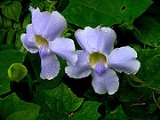
Thunbergia laurifolia
Encyclopedia
Thunbergia laurifolia, Laurel clock vine or Blue trumpet vine, is native to India
(Starr et al., 2003) and the Indomalaya ecozone, the species occurs from Indochina
to Malaysia (Schonenberger, 1999). It is locally known as kar tuau in Malaysia and rang jeud in Thailand
(Chan & Lim, 2006).
The plant flowers almost continuously throughout the year with flowers opening early in the morning and aborting in the evening of the same day. Carpenter bees are frequent visitors, creeping into the flowers for pollen and nectar while black ants are present probably as nectar scavengers. The plant develops a very tuberous root system (NRM, 2003).
in tropical gardens. It is a long blooming vine in cultivation. Propagation is from stem cuttings or shoots from the tuberous roots. It is a fast-growing perennial herbaceous climber. it has become an exotic weed in many tropical countries.
where escaping from ornamental garden uses into native habitat
s in supportive climates. Because it is a fast-growing perennial plant it has become an escaped exotic and noxious weed in many tropical countries The plant has become a weed found in the Cerrado
vegetation
of Brazil
, and in tropical areas of Australia.
India
India , officially the Republic of India , is a country in South Asia. It is the seventh-largest country by geographical area, the second-most populous country with over 1.2 billion people, and the most populous democracy in the world...
(Starr et al., 2003) and the Indomalaya ecozone, the species occurs from Indochina
Indochina
The Indochinese peninsula, is a region in Southeast Asia. It lies roughly southwest of China, and east of India. The name has its origins in the French, Indochine, as a combination of the names of "China" and "India", and was adopted when French colonizers in Vietnam began expanding their territory...
to Malaysia (Schonenberger, 1999). It is locally known as kar tuau in Malaysia and rang jeud in Thailand
Thailand
Thailand , officially the Kingdom of Thailand , formerly known as Siam , is a country located at the centre of the Indochina peninsula and Southeast Asia. It is bordered to the north by Burma and Laos, to the east by Laos and Cambodia, to the south by the Gulf of Thailand and Malaysia, and to the...
(Chan & Lim, 2006).
Description
Thunbergia laurifolia leaves are opposite, heart-shaped with serrated leaf margin and taper to a pointed tip. Flowers are not scented and borne on pendulous inflorescences. The hermaphrodite flower is trumpet-shaped with a short broad tube, white outside and yellowish inside. The corolla is pale blue in colour with 5–7 petals, one larger than the others.The plant flowers almost continuously throughout the year with flowers opening early in the morning and aborting in the evening of the same day. Carpenter bees are frequent visitors, creeping into the flowers for pollen and nectar while black ants are present probably as nectar scavengers. The plant develops a very tuberous root system (NRM, 2003).
Cultivation
Thunbergia laurifolia is a popular ornamental plantOrnamental plant
Ornamental plants are plants that are grown for decorative purposes in gardens and landscape design projects, as house plants, for cut flowers and specimen display...
in tropical gardens. It is a long blooming vine in cultivation. Propagation is from stem cuttings or shoots from the tuberous roots. It is a fast-growing perennial herbaceous climber. it has become an exotic weed in many tropical countries.
Teas and Medicinal
In Malaysia, juice from crushed leaves of T. laurifolia are taken for menorrhagia, placed into the ear for deafness, and applied for poulticing cuts and boils (Burkill, 1966). In Thailand, leaves are used as an antipyretic, as well as an antidote for detoxifying poisons (Kanchanapoom et al., 2002). Several Thai herbal companies have started producing and exporting rang jeud tea (Chan & Lim, 2006). The tea has been claimed to be able to detoxify the harmful effects of drugs, alcohol and cigarettes.Chemistry
Iridoid glucosides have been isolated from T. laurifolia (Kanchanapoom et al., 2002). Microwave-dried leaves displayed stronger antioxidant properties (AOP) than fresh leaves (Chan & Lim, 2006). AOP of infusion from microwave-dried leaves were higher than the commercial rang jeud tea from Thailand.Invasive species
Thunbergia laurifolia can become an invasive speciesInvasive species
"Invasive species", or invasive exotics, is a nomenclature term and categorization phrase used for flora and fauna, and for specific restoration-preservation processes in native habitats, with several definitions....
where escaping from ornamental garden uses into native habitat
Habitat
* Habitat , a place where a species lives and grows*Human habitat, a place where humans live, work or play** Space habitat, a space station intended as a permanent settlement...
s in supportive climates. Because it is a fast-growing perennial plant it has become an escaped exotic and noxious weed in many tropical countries The plant has become a weed found in the Cerrado
Cerrado
The Cerrado, is a vast tropical savanna ecoregion of Brazil, particularly in the states of Gioas and Minas Gerais...
vegetation
Vegetation
Vegetation is a general term for the plant life of a region; it refers to the ground cover provided by plants. It is a general term, without specific reference to particular taxa, life forms, structure, spatial extent, or any other specific botanical or geographic characteristics. It is broader...
of Brazil
Brazil
Brazil , officially the Federative Republic of Brazil , is the largest country in South America. It is the world's fifth largest country, both by geographical area and by population with over 192 million people...
, and in tropical areas of Australia.
See also
- Flora of IndiaFlora of IndiaThe Flora of India is one of the richest of the world due to a wide range of climate, topology and environments in the country. It is thought there are over 15000 species of flowering plants in India,which account for 6 percent of the total plant species in the world. and probably many more species...

